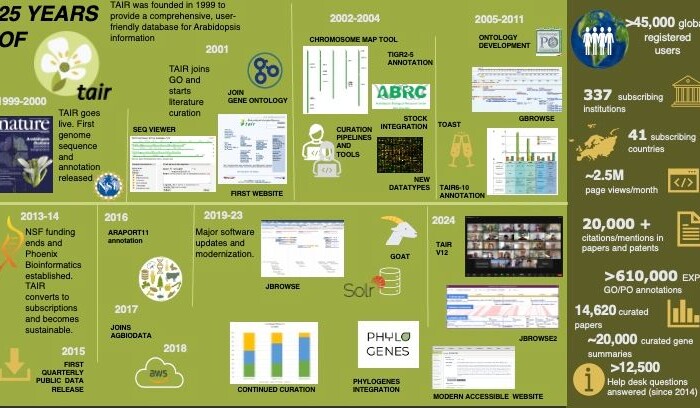 Two weeks ago, I was fortunate to be able to attend PlantBiology 2022 in Portland, Oregon. It was a great opportunity to interact with this welcoming and innovative community. I am thankful for the many folks that stopped by the Phoenix booth and shared how they use resources like TAIR in their work. It was also very inspiring to attend the Bioinformatics workshop organized by Phoenix’s Dr. Shabari Subramaniam and learn about all of the exciting and transformative work happening at digital research resources across the community.Immersion in these topics made me ponder how Digital Research Resources (DRRs) are different from other things supported with research funding (pictured from left to right are workshop presenters Asher Pasha, Pankaj Jalswal, Shabari Subramaniam, Rashmi Jain, Jason Williams, Sook Jung, Richard Barker, and Janeen Braneen). I suggest that DRRs are different in that they are intended to be used as part of other researchers’ workflow. It is this active use and goal of adoption that makes DRRs different. A researcher incorporating a DRR in their workflow takes on some level of dependency on that DRR.
Two weeks ago, I was fortunate to be able to attend PlantBiology 2022 in Portland, Oregon. It was a great opportunity to interact with this welcoming and innovative community. I am thankful for the many folks that stopped by the Phoenix booth and shared how they use resources like TAIR in their work. It was also very inspiring to attend the Bioinformatics workshop organized by Phoenix’s Dr. Shabari Subramaniam and learn about all of the exciting and transformative work happening at digital research resources across the community.Immersion in these topics made me ponder how Digital Research Resources (DRRs) are different from other things supported with research funding (pictured from left to right are workshop presenters Asher Pasha, Pankaj Jalswal, Shabari Subramaniam, Rashmi Jain, Jason Williams, Sook Jung, Richard Barker, and Janeen Braneen). I suggest that DRRs are different in that they are intended to be used as part of other researchers’ workflow. It is this active use and goal of adoption that makes DRRs different. A researcher incorporating a DRR in their workflow takes on some level of dependency on that DRR.
This matters because DRRs are often supported through funding allocated for research. When DRRs are initially created this is rarely a conflict since they typically include some significant element of research. The DRR might seek users within one scientific discipline (e.g. biology, geosciences, etc) and contribute research in another area (e.g. computer science); however, the project qualifies as research. This relationship can become more complicated as DRRs mature. Over time DRRs, or certain services within them, may no longer fit as research.
DRRs with a community of users that rely on the services offered for their own research workflow have started the transition from being primarily research to primarily being an ongoing service which supports their users. The creation of a reliable and widely-used DRR is advantageous for the research community. For DRRs supported with research funding, this successful transition from Research to Operations (R2O) can result in another challenge.
There is a likely chasm between their former research funding and a future funding model based on ongoing operations. This is the proverbial R2O chasm. In future posts, I’ll expand on the options for the developers of DRRs in the position of providing ongoing services. I’ll also cover what we as a research community can do to support funders and users as the chasm approaches.



